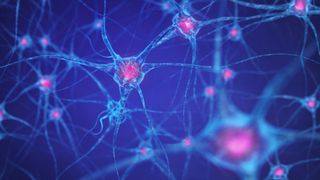11 children diagnosed with new form of ALS
Researchers may have identified a potential treatment for the rare condition.

Six years ago, a teenager from Italy traveled to the U.S. in hopes of finding a diagnosis for her mysterious medical condition, which had caused her to lose the ability to walk and required her to have a breathing tube. Now, researchers have diagnosed the teenager, Claudia Digregorio, and 10 other children with a new form of amyotrophic lateral sclerosis (ALS) that strikes in childhood and progresses more slowly than what is typically seen with this condition.
In addition, the researchers have pinpointed a gene that seems to cause this form of ALS, and they may have also identified a potential treatment for the condition, according to a study describing the findings, published Monday (May 31) in the journal Nature Medicine.
"We hope these results will help doctors recognize this new form of ALS and lead to the development of treatments that will improve the lives of these children and young adults," Dr. Carsten Bönnemann, senior investigator at the National Institute of Neurological Disorders and Stroke (NINDS) and a senior author of the study, said in a statement. "We also hope that our results may provide new clues to understanding and treating other forms of the disease."
Related: 10 things you didn't know about the brain
ALS is a rare disease that causes progressive degeneration and death of the nerve cells that control voluntary muscle movements, such as chewing, walking, talking and breathing, according to the NINDS. Most people with ALS develop symptoms between ages 55 and 75, and the disease usually progresses rapidly, with death occurring in three to five years after diagnosis.
But with the new form of ALS, symptoms appeared much earlier, often around 4 years of age. For many of the 11 patients, problems with walking and spasticity in their lower limbs were the first signs of the disease. By the teenage years, many of the patients, like Digregorio, required a wheelchair for mobility and a tracheostomy tube for breathing support. Before Digregorio left for the U.S., the then 15-year-old met with Pope Francis, who offered prayers for her health, according to a 2015 issue of the NIH Record, a newsletter of the National Institutes of Health.
The researchers found an answer for Digregorio, who was the first patient included in the study. Despite developing symptoms at such an early age, she and the other 10 children showed hallmark signs of ALS on neurological exams, including severely weakened or paralyzed muscles, the researchers said.
Sign up for the Live Science daily newsletter now
Get the world’s most fascinating discoveries delivered straight to your inbox.
"These young patients had many of the upper and lower motor neuron problems that are indicative of ALS," said study lead author Dr. Payam Mohassel, a clinical research fellow at the NIH. (Motor neurons are nerve cells in the brain and spinal cord that send signals that control movement. Upper motor neurons originate in the brain and send signals to the lower motor neurons, which are in the spinal cord.) "What made these cases unique was the early age of onset and the slower progression of symptoms," Mohassel said. "This made us wonder what was underlying this distinct form of ALS."
Using genetic sequencing, the researchers found that these patients had genetic changes in a specific section of a gene called SPLTC1. This gene is involved in the production of fats called sphingolipids, which are particularly abundant in brain tissue. A number of other deadly neurodegenerative diseases, including Nieman Pick disease and Tay-Sachs disease, are also caused by problems with sphingolipid metabolism.
Further research revealed that the mutation in SPLTC1 increased the levels of sphingolipids. Specifically, the researchers found that the mutation "takes the brake" off of an enzyme involved in the production of sphingolipids, meaning the body keeps churning out these fats without its usual feedback system to tell it when to stop.
The findings mean that restoring this "brake" might treat this type of ALS, the authors said.
In another experiment, the researchers tested a therapy called small interfering RNA, or siRNA, in which small strands of RNA work to "silence" a mutated gene — in this case, SPLTC1. In studies in lab dishes, the therapy worked to restore sphingolipids levels to normal.
"Our ultimate goal is to translate these ideas into effective treatments for our patients who currently have no therapeutic options," Bönnemann said.
Future studies should also look into whether problems with sphingolipid metabolism play a role in other forms of ALS, the authors said.
Originally published on Live Science.

Rachael is a Live Science contributor, and was a former channel editor and senior writer for Live Science between 2010 and 2022. She has a master's degree in journalism from New York University's Science, Health and Environmental Reporting Program. She also holds a B.S. in molecular biology and an M.S. in biology from the University of California, San Diego. Her work has appeared in Scienceline, The Washington Post and Scientific American.
Most Popular

